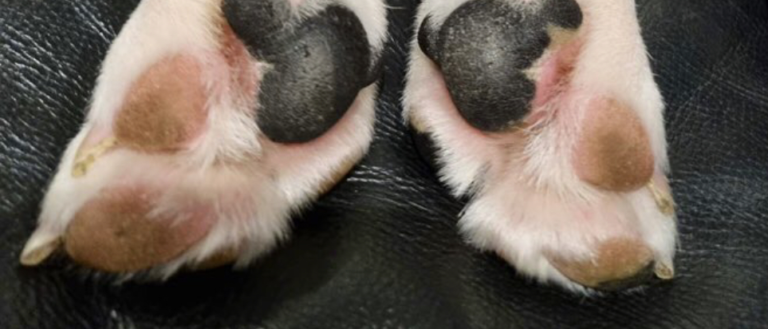Today, pet parents, I’d like to talk about interdigital cysts in bulldogs – and if you’ve ever seen a small bump between the toes of your bully’s paws, then they might have one. It’s a fairly common medical issue for the bulldog breed, including French and American, but it’s also fairly easy to treat – in the earlier stages, of course.
Let’s take a closer look at interdigital cysts, where you might find them, and what you should probably do about them.
What are interdigital cysts?
If you think of fingers or toes as digits, interdigital literally means in-between the fingers or toes.
Cysts are, in their most basic form, lumps of fluid, usually pus, caused by a blockage of something like a duct or gland.
Interdigital cysts, also known as furuncles or follicular cysts, are lumps or nodules, usually found around or on the webbing between your bulldog’s individual toes.
Technically, interdigital cysts aren’t “true” cysts. True cysts are filled with fluid, but interdigital cysts are commonly swollen, red, and inflamed tissue, causing a nodule rather than a fluid-filled lump.
The bumps can explode or erupt, becoming infected, cause a great deal of itchiness and irritation for your pet, and can cause scarring and cellulitis if left ignored and untreated.
Are interdigital cysts common in bulldogs?
Yes, interdigital cysts are common in bulldogs – and other bulldog breeds.
According to experts, the following makes a dog more high-risk for developing them:
- Overweight
- Obese
- Prone to allergies (which bulldogs are)
- Short-haired breeds
- Dogs with a tendency to overgroom
- Larger webbing between the toes
- Arthritic dogs with reduced mobility
- Dogs forced to live in cages or other places with very rough floors
Along with English bulldogs, basset hounds, mastiffs, shar-peis, pit bulls, labradors, great Danes, German shepherds, and boxers are the most common breed of dogs to get interdigital cysts.
What causes interdigital cysts?
Interdigital cysts have several causes, according to experts. Sometimes, your pup can have more than one underlying cause. The most common causes include:
- Irritation
- Bacterial infection
- Hair embedding into the skin
- Constant pressure on the paws
- Excess pressure on the paws
- Hair follicle damage or blockages
- Allergies/allergens
- Abnormal friction between the toes
- Skin mites
- Foreign bodies
- Certain diseases of the endocrine system
Symptoms of interdigital cysts
You will need to take a closer look at your bulldog’s paws to see the interdigital cyst or cysts, but they might display a few symptoms that you can notice from afar, including:
- Limping
- Dragging the leg(s)
- Excessively licking or biting at affected areas
- Whining
- Reduced interest in playing or toys
- Not letting you go near affected areas
Once you get up close to your pup, take a closer look at their paws, specifically between the toes. Alongside the cysts themselves, you may also notice reddening of the skin, thickening of the skin, flaking/scaling skin, and, of course, the nodules or lumps – cysts.
The cysts can burst, which can cause pus and other fluids to ooze out.
The cysts themselves are usually dark pink, red, or purple in colour. The way they expand the skin will make it appear super shiny, or shiner than usual. Hair will more than likely be missing from the nodule areas, and hair loss can also occur all around the affected areas, especially if your bully has been overgrooming the areas.
Your bulldog can have multiple cysts on the webbing between two toes, but also on the webbing between other toes, too. They can appear all at once, or at different times. Some dogs will repeatedly suffer from them – especially bulldogs, that can’t alter their stocky frame or chonky fat rolls.
Treatment for interdigital cysts in bulldogs
When it comes to treatment for interdigital cysts in bulldogs, a lot of it is focused on relieving the pain and discomfort they feel, while also reducing the risks of infection. Antibiotics are common. Some vets will recommend topical steroid treatments and/or anti-inflammatory medications, or medicated bathing products.
Treatments will likely be pills, topical treatments (like creams,) or injections. Again, your vet will discuss the best options for you and your bulldog.
For very severe cases, vets might recommend surgery, but all this does is, essentially, stitch two affected toes together to prevent the webbing between them from becoming affected again.
Surgery, obviously, doesn’t solve the problem. The interdigital cysts can appear on other toe webbing, and the surgery can also permanently alter walking, standing, and more for your four-legged friend.
Another long-lasting and less problematic treatment for interdigital cysts is carbon dioxide laser therapy, known as CO2 laser. This helps to get rid of the super thin, damaged skin but doesn’t permanently affect movement.
The local environment of your bulldog may need to be adapted or modified, such as avoiding certain floor cleaning products and other known allergens.
FAQ
Can you use home treatments and remedies for interdigital cysts in bulldogs?
Anti-fungal, antibacterial, and anti-inflammatory medicated baths will offer some relief for your dog’s sore paws, but it might not get to the heart of the problem without a vet performing diagnostic tests and offering a complete diagnosis. Interdigital cysts can have several different causes, including allergens and trauma. In order to treat the cysts, you must first work out what they’re happening – and how to stop it.
Can interdigital cysts burst?
Yes, your bulldog’s interdigital cysts can burst or rupture. When this happens, the inside fluid will leak or drain out – often clear fluid, tinged with some blood. This will leave an open wound that is at risk of developing an infection and can cause your bulldog great pain, discomfort, and mobility issues.
Interdigital cysts in bulldogs: conclusion
They don’t look pleasant to us, pet parents, but interdigital cysts can be extremely painful for your four-legged friends. If you see any kind of redness or bump around your bulldog’s toes, you should make an appointment to see your vet as soon as possible. This ensures that the problem is diagnosed early, leading to prompt treatment, but also helps to ensure that there aren’t further underlying conditions that could prove more serious.



